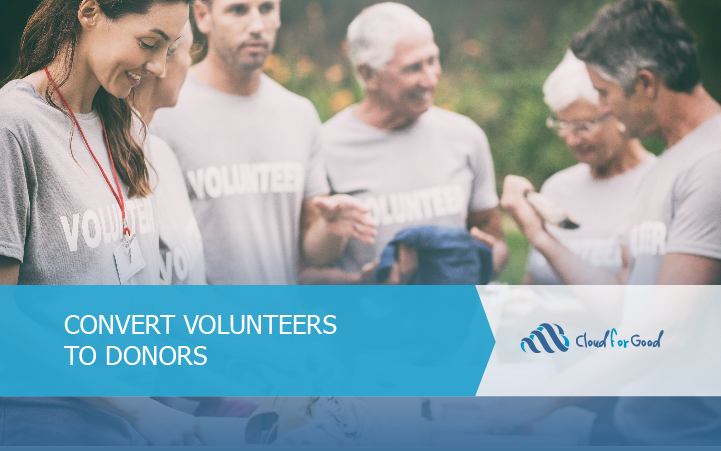Prior to joining Cloud for Good, I worked with a nonprofit in Atlanta called Points of Light whose mission was to increase capacity for other nonprofit organizations through volunteer mobilization. We worked with organizations of all sizes: some with just a few full-time staff, others with dozens, and everything in between. Most organizations we worked with tended to rely on volunteers in one way or another, whether to meet mission critical deadlines a few times a year, or regularly throughout the life of a program. Finding those volunteers was always a priority, and technology often helped fill the gaps in operational capacity when it came time to recruit and retain engaged individuals who believed in the various missions of the organizations that relied on their help.
In the nonprofit world, we also know that organizations often rely on donors to fund programs and maintain the organizations’ ability to meet their missions. And technology often plays a part in this effort as well. For example, at Points of Light we used Salesforce to manage our fundraising activities and maintain our donor history database, just as other organizations used Salesforce to manage and track volunteers and their hours.
In midsize to large organizations, often these efforts take place in siloed departments, but it makes the most sense to align those priorities and leverage the same technology to recruit both volunteers and donors. And one thing that any organization with a robust history of volunteer and donor recruitment can tell you is that volunteers often make excellent donors as well, and vice versa. It is easy to approach fundraising as a standalone activity as you develop campaigns to engage individuals and households that believe in your mission and convince them to support the organization monetarily. But why not leverage the relationship you already have with your volunteers to convert them into donors?
Volunteers who are regularly engaged already believe in your mission; it is what brings them to your offices and out into the field to get their hands dirty, so to speak. And it is your mission that creates repeat donors as well. This common thread may seem obvious, but it is often easy to forget that these two areas of capacity building can be aligned for the same end: to meet your mission.
Generating new donors is something that any fundraising officer has on their mind all day, every day, just as volunteer managers are focused on recruiting new volunteers every day. So why not help each other out? Make the case to your regularly engaged volunteers that a recurring donation would go above and beyond their current commitment to the organization and provide more capacity for the organization to meet milestones without the need to drastically increase their operating budgets.
The inverse is also true! Volunteers make great donors and donors make great volunteers. Why not include a volunteer call to action in your next fundraising campaign? Encourage donors to give a few hours every now and then, and incentivize their engagement. For example, if you leverage fundraising tiers to categorize donors by their level of giving, offer a soft credit for donors who also give a certain number of volunteer hours; this enables donors to reach that next level of engagement with just their monetary value of the hours they volunteer. According to the Independent Sector and the Bureau of Labor Statistics, one volunteer hour is currently valued at $23.56 per hour. If a donor provides four hours of volunteer time in a single day, perhaps credit them for $100 in giving as well.
Salesforce makes it easy to align volunteer and donor recruitment by providing a single, comprehensive relational database that allows you to manage an individual’s details for both areas on a single screen. Rather than thinking of technology in terms of silos and departments, think about the total picture of one individual’s possible contributions to your organization. Whether they donate regularly each month, or come out to volunteer a few times a year, they are helping you build capacity, which in turn helps you meet your mission.
The Nonprofit Success Pack enables you to track volunteers and donors with functionality that lets you marry these two recruitment and management areas. When you look up an individual’s donation history, you can also see their volunteer history at a glance, allowing you to have a complete and accurate picture of their ability to impact your efforts and help you meet your mission. And it’s all about your mission. Whether you leverage Salesforce mainly to do one or the other, it helps to think of your contacts as possible donors and volunteers. And sure, not all individuals will want to go the extra distance by giving both time and money, but many will. If you’re not thinking of these efforts as aligned and overlapping, you’re likely missing out on key contributions from engaged individuals who help provide lifeblood to your organization. In the nonprofit world, people are the key, and technology is the key ring. By leveraging Salesforce as a single system of truth, you can begin to identify areas for improvement and engagement with donors and volunteers with comprehensive decision data, making it easier to make the big ask when it comes time to recruit. Don’t miss out on building capacity for your organization! Convert your volunteers into donors, and convert your donors into volunteers; Salesforce and the Nonprofit Success Pack makes it easy.
You may also be interested in reading the following posts:





